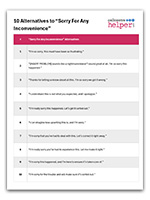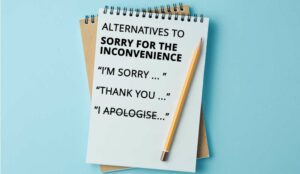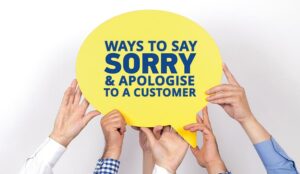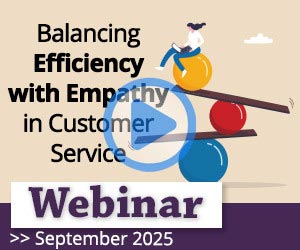The phrase “Sorry for the inconvenience” is often used in customer service, but it has become a cliché that lacks sincerity and can feel dismissive to customers. It fails to acknowledge the specific issue or the customer’s feelings, making the apology seem generic and impersonal.
So what is the best way to apologize for the mistake and the inconvenience?
Liz Doig of Wordtree shares her advice for avoiding awful apology statements like “sorry for the inconvenience” and turning “sorry” into lifelong loyalty.
Where Can Customer Service Apologies Go Very Wrong?
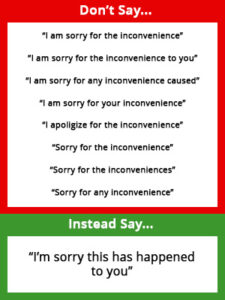
No one likes dealing with angry customers. And if we’re honest, a lot of organizations botch it when they do, using phrases like: “Sorry for any inconvenience”.
Yet with the right approaches in place, complaints can become a golden opportunity to turn unhappy customers into lifelong supporters and advocates of your brand.
For Example, you should say “I’m sorry this has happened to you” instead of saying:
- “Sorry for any inconvenience”
- “Sorry for the inconvenience/s”
- “I am sorry for the inconvenience”
- “I am sorry for your inconvenience”
- “I apologize for the inconvenience”
- “I am sorry for the inconvenience to you”
- “I am sorry for the inconvenience to you”
- “I am sorry for any inconvenience caused”
Imagine this scenario for a second. There’s a very nice woman on the phone who’s paid your organization a chunk of money to deliver flowers to her mother-in-law.
The only thing is, the flowers never arrived – and now her mother-in-law thinks she forgot her birthday. The woman is upset and angry and wants your organization to respond.
Sitting in the contact centre is another very nice person. In fact, he gravitated towards customer service because he loves helping people. Conflict is very much not his thing. So when the angry woman on the phone starts demanding what he is going to do about all this, he withdraws emotionally and tries to find safe ground.
And in the context of a contact centre, “safe ground” often means:
- Using language that creates distance between you and your customer
- Falling back on scripts and policies
- Issuing non-apologies
Let’s take a look at each of these issues and share advice for avoiding each of them, with the aim of giving apologies that are warm and sincere.
1. Your Apology Can Create Distance
This is when you – usually subconsciously – push a subject away from yourself by using words and phrases that make events seem as unconnected to you as possible.
Here’s an example:
Don’t Say This
The flowers were paid for on March 14 and delivery was confirmed for March 18, but no delivery occurred?
Instead Say This
OK, so we took payment for the flowers on March 14, and we confirmed they’d be delivered on March 18… but then they just didn’t arrive?
It’s a subtle, but important difference. In grammatical terms, the second version feels distant because it uses the “passive voice”. Or in other words, no people are referred to in the communication. “We” didn’t get it wrong. It was “the delivery” that failed to happen.
To your customer, it feels like you’re not taking ownership. And because the process of delivering the flowers is talked about rather than the people involved in that process, the customer begins to feel less important than the process, and that they are dealing with a robotic, heartless organization.
This is part of the problem with phrases like: “Sorry for the inconvenience.” They don’t feel genuine and they miss an opportunity to show that you care.
For more advice for showing that you care when apologizing in the contact centre, read our article: Customer Service Apologies – Keeping Sorry Fresh and Sincere
2. Falling Back on Scripts and Policies
Another safe place an advisor might want to retreat into is scripts and policies.
So when the customer raises her voice and demands to know what he’s going to do about it, it wouldn’t be unusual for the advisor to say something like:
“Our delivery policy states that deliveries will usually be made on the date selected, between the times of 7am and 7pm, and that a signature will be required upon delivery. In the event of adverse weather conditions, civil disturbance or other disruption, there is no guarantee of delivery.”
Again, the advisor does not know what to do with the angry woman and is treating the conversation like a game of ping-pong. As long as the advisor says something in response, they feel like they are doing their job correctly and their evaluation won’t suffer.
The customer, meanwhile, is now heading to somewhere between incandescent and apoplectic rage. Not only does the customer feel a little foolish for trusting you to get this right, but the advisor now seems to be taking the mick.
3. Issuing Non-Apologies
Many companies – especially those with in-house legal teams – have a fear of saying sorry. They worry that apologizing can be interpreted as an admission of liability. So they ban – or at least strongly discourage – employees from apologizing.
For customer services teams, this is difficult. If you’re talking to someone who’s clearly had a rubbish experience, what else do you do but apologize?
Well, unfortunately, many issue the non-apology. The sorry-not-sorry that is expressed along the lines of “I’m sorry if you feel that way”, or “I’m sorry if you feel this has caused you inconvenience.”
Oh boy. To a customer, talking this is like pouring oil on an already raging fire. Because what these non-apologies do is portray the complaint as being all in your customer’s head. You’re only sorry about their feelings, not what happened.
As a result of these standard lacklustre approaches to saying “sorry”, some customers won’t use your organization again – and they’ll advise their friends not to either. If they’re angry enough, some will hit social media, venting their unhappiness to the world at large.
But there’s another way to do it. Instead of making your customers feel like they mean nothing to you – and that your contact centre is there as a barrier between them and the organization, rather than a welcoming and helpful interface with it – you can turn complaints into golden moments. Here’s how…
For more phrases to avoid – like: “I’m sorry for the inconvenience” – read our article: 15 Things a Call Centre Agent Should Never Say (But Many Do)
Alternatives to “Sorry for Any Inconvenience”
Knowing what’s best to say is one thing. But in the heat of the moment, it’s easy to slip back into bad habits.
Time and training help to establish new normals. So as you’re looking to create better ways of helping unhappy customers, here are some better things to say than: “Sorry for the inconvenience…”.
- “I’m so sorry, this must have been so frustrating.”
- “[INSERT PROBLEM] sounds like a nightmare/doesn’t sound great at all. I’m so sorry this happened.”
- “Thanks for letting us know about all this. I’m so sorry we got it wrong.”
- “I understand this is not what you expected, and I apologize.”
- “I’m really sorry this happened. Let’s get it sorted out.”
- “I can imagine how upsetting this is, and I’m sorry.”
- “I’m sorry that you’ve had to deal with this. Let’s correct it right away.”
- “I’m really sorry you’ve had to experience this. Let me make it right.”
- “I’m sorry this happened, and I’m here to ensure it’s taken care of.”
- “I’m sorry for the trouble and will make sure it’s sorted out.”
Printable – 10 Alternatives to “Sorry For Any Inconvenience”
Do you want to download this to share with your team?
Get your free download of 10 Alternatives to “Sorry For Any Inconvenience” now:
An Approach for Offering Great Customer Service Apologies
When we’re angry or upset, what most of us want to hear from the person who’s made us this way is:
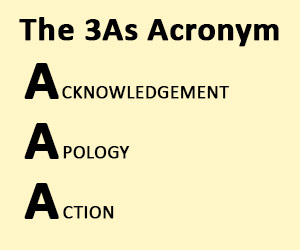
These three As are the key to getting angry, unhappy people back on side.
Acknowledgement
Acknowledging that someone has a reason to be upset is important. Let’s imagine, for example, that your neighbour’s car blocks your drive and as a result, you’re late for work.
When you see them, you aren’t best pleased. But if your neighbour immediately says: “Oh no, I’m completely blocking you in… I had no idea… I’m so sorry,” you might still be annoyed, but it would be very difficult to be more mad at her.
Apology
The Apology is important too. We should tell advisors: “Apologize once, apologize well.” By this we mean, it’s useless to either party if you just keep apologizing. So don’t waste their time with it. But apologize once, sincerely and openly.
For the customer whose mother-in-law didn’t get flowers, this would mean the agent saying: “Oh no, that doesn’t sound great… let me look into it for you… it appears the delivery was withdrawn, but I don’t know why… I’m so sorry, let’s sort this out now…”
Sorting things out is important. Human beings have an innate sense of what is fair and what is not. If we feel we’ve been treated unfairly, it makes us deeply upset.
But the upside of this is that the vast majority of people are hardwired to play fair too – so customers tend to be very forgiving if you put your hands up, say sorry and explain what you’re going to do to put things right.
Action
The Action you take will have far more impact if it’s thoughtful and tailored. For example, for the woman who wanted to send flowers, you will of course refund her.
But you could go a tiny step further and send flowers to both her and her mother-in-law, along with a little note to say sorry, and that it was your mistake.
The way you express all of these things has to feel genuine and heartfelt. Don’t create distance. Don’t fall back on scripts and policies – and don’t, whatever you do, say: “Sorry-not-sorry.”
For more on the first of the 3As – showing acknowledgement – read our article: The Top 12 Acknowledgement Statements for Customer Service
Key Tips for Saying “Sorry” Well
While the approach above helps to give your apology great structure, the following tips are also great to keep in mind when thinking about your customer service apologies.
Make Sure Your Quality Scorecard Accommodates Complaints and Apologies
If you want advisors to deliver a perfect complaints experience, then you may have to tweak your quality assurance (QA) and evaluation criteria.
Average Handling Time (AHT), for example, should not be assessed the same way for dealing with complaints as it might be in other situations.
Angry people need to vent. Your advisor needs to listen. This will take extra time. Those thoughtful actions that will make your angry customer loyal for life will also need a few minutes.
Does your framework even allow angry calls to be categorized as complaints? Some systems only recognize a complaint if a caller – or person who writes a letter or email – uses the word “complaint” or “complaining”. So it may be worth broadening what can qualify as a complaint and empowering your advisors to tag complaints themselves.
For more advice on building the ideal quality scorecard, read our article: How to Create a Contact Centre Quality Scorecard – With a Template Example
Train Advisors to Deal With Angry and Upset Customers
Our survival instincts have been honed over millennia to protect us from threatening situations – so no one really likes talking to angry people.
On top of this, customer services people are often highly empathetic, and therefore quite sensitive. Which can make it even more difficult for advisors to deal with angry calls well.
So train your teams. Let them know that an angry person is a person who wants help – and that if they help them by acknowledging, apologizing and taking thoughtful action, then they’ll have the ability to turn the customer into a lifelong advocate.
Make sure your teams feel supported. And be sure they know their evaluation will not suffer if they need to take time to respond to complaints in ways that are more likely to result in gold-standard customer loyalty.
For advice on handling many different types of difficult customers, read our article: How to Handle Contacts From Challenging Customers
Get Rid of Your Complaints Teams
If you have a dedicated “complaints” team that’s staffed by colleagues who’ve been around forever – then think of disbanding it.
Especially in regulated industries, there can be a feeling that because complaints often stray into legal or compliance issues, then you need specialist teams to deal with them. However, specialist complaints teams tend to be made up of people who – thanks to their role – only ever see the company and its customers in the worst possible light.
Specialist complaints teams tend to be made up of people who – thanks to their role – only ever see the company and its customers in the worst possible light.
If you talk to a complaints team, it isn’t unusual to hear them rattle off all the things that the company is doing badly – but have little idea about what it’s doing brilliantly. This shouldn’t be surprising, because their day-in, day-out experience is hearing about everything that goes wrong.
Also, after a while, you can’t blame them for thinking that they work for a failing company. They can also develop a jaded view of customers – because as well as all the genuine complaints, they deal with the serial, or even professional, complainers. It’s not difficult for complaints team colleagues to feel they live in a world where their company is terrible and customers are con artists.
If you think a dedicated complaints team is necessary, then rotate people from across the entire business to work in it. They’ll gain brilliant insight into what customers want and need – and of course, into what they don’t want at all.
Alternatively, think about absorbing complaints into the main body of the contact centre, so that everyone deals with a mixture of happy, middling and angry customers.
Schedule Conversations With Your Colleagues in Legal
If your colleagues in legal (and/or compliance, if you work in a regulated industry) have strong views about apology, schedule some time to talk to them. It might also be helpful to involve colleagues from Brand in the conversation too.
Use the meeting to explain that non-apology has the potential to cause reputational damage – and that you feel you’d be better able to deliver a brand-aligned experience if your advisors can say “sorry” when it’s appropriate.
Tell your legal colleagues that you’ll be happy to include their input into training and onboarding – but that you can’t have a situation where it’s impossible to apologize.
Apologising When it Isn’t Your Fault
Sometimes customers complain about things that have got nothing to do with your company or its services. The simple rule here is that if it’s not your fault, then don’t apologize.
However, you should be warm and friendly in your response. This can look like the first example, not like the second.
A Good Example of An Apology Letter
Dear Joe,
Thanks for your patience while we looked into the colour fade on your jacket.
The independent labs we use to investigate possible faults say the fading is due to sunlight. They’re suggesting that your jacket may be hanging somewhere where one arm is exposed to very bright sunshine. I’ve attached their findings to this letter.
This isn’t a fault, and so we won’t be refunding you for the jacket.
Kind regards,
John Smith
A Bad Example of An Apology Letter
Dear Joe,
Further to our investigation into your complaint regarding colour fade on your Winter Solstice Down Jacket, I can confirm that all fading was in fact due to uneven UV exposure.
The working assumption of independent experts at XYZ Laboratories is that this has been a storage issue rather than a fault and we are therefore rejecting your claim for compensation.
Please refer to our terms and conditions of sale for further information.
Kind regards,
John Smith
So the next time an angry customer gets in touch, fight your instincts to run a mile. Think instead about how you can meet all their needs and turn her into a loyal brand advocate for life.
Final Thoughts
Customers hate it when your apology is non-committal; they want you to take ownership of the issue and show empathy. This can help you turn a negative customer experience into something much more positive.

The 3As approach outlined in this article will help you do just that, as well as the extra tips and great customer service apology examples that we’ve also presented.
Good luck and do your NPS a favour, and never use the phrase: “Sorry for any inconvenience caused” ever again.
Written by: Liz Doig, Founder and Strategic Lead at Wordtree
For more language advice for creating more positive contact centre conversations, read our articles:
- How to Write a Customer Apology Letter – With an Example
- Top 25 Positive Words, Phrases and Empathy Statements
- 17 Probing Questions to Improve Your Customer Service
Author: Liz Doig
Reviewed by: Hannah Swankie
Published On: 25th Mar 2020 - Last modified: 23rd Sep 2025
Read more about - Customer Service Strategy, Apologies, Empathy, Free Downloads, Handling Customers, Language, Liz Doig, Rapport, Service Strategy






